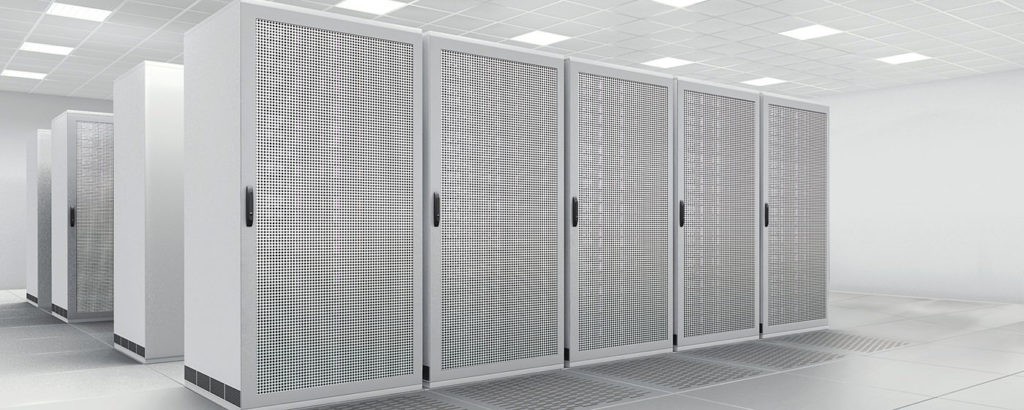
Cooling server rooms with room air conditioners? That sounds enticing to many a data center operator. Room air conditioners were not originally designed for use in equipment rooms (precision air-conditioning systems capable of regulating room temperature much more accurately were developed for that job), but they have become much cheaper recently, and in tests they now deliver similar results to precision systems. So what is wrong with the idea of saving on an expensive precision air-conditioning system and instead investing in a room air conditioning system?
The answer is in fact: everything. Because the concept underlying room air conditioners is completely different from that of precision systems. Whereas roughly 90 % of a precision air-conditioning system’s function is sensitive cooling – meaning it actually lowers the room temperature – about 40 % of a room air conditioner’s function is so-called latent cooling. In this mode, the air is dehumidified rather than the room temperature being lowered – so in purely physical terms no cooling actually takes place. That seems absurd at first hearing, but it is nevertheless quite logical. Because the purpose of room air conditioners is to create a room climate which people find comfortable. But humans’ temperature perception is linked to the humidity of the air. If it decreases, people will perceive what is actually the same temperature as being cooler. Room air conditioning systems utilize this difference between the actual and perceived room temperature: They first remove humidity from the air, and only switch to physically detectable sensitive cooling when the dehumidification effect alone is no longer sufficient.
Air-conditioning of equipment rooms
This air-conditioning method has proved successful in rooms used by people. If it is applied in equipment rooms, however, the air-conditioning provided will not be appropriate. That is illustrated even by the operating point: Whereas the target for equipment rooms is a temperature of 24 °C and 50 % relative humidity, room air conditioners are designed to produce a temperature of 27 °C and 48 % relative humidity in summer (cooling mode). So for the cooling of equipment rooms room air conditioners vary from the optimum operating point, reducing their energy efficiency and increasing electricity costs. Another problem is latent cooling: In server rooms, especially, the air is so dry that often air humidifiers are used to prevent electrostatic discharge. If room air conditioners, which initially remove humidity from the air, are installed in such a room, efforts to humidify the room will be counteracted. A further factor is that if the air humidity is too low the room air conditioner’s heat exchanger will dry out. This reduces the heat transfer surface area, and as a result the heat exchanger loses more than 25 % of its effect. This loss of efficiency may reduce the heat transport through the refrigerant to such an extent that the system temporarily shuts down because the evaporation temperatures are too low, and only resumes working again as the air humidity rises. The results of this on-off operation are enormous temperature fluctuations in the server room, which can lead to overheating and consequently damage the IT equipment.
But it is not only the excessive dryness of the air which make it seem unfeasible to install room air conditioners in server rooms. Room air conditioning systems are also unsuitable as a solution because of the air circulation required in such rooms. Being intended to optimize human wellbeing, they are designed not to create any unpleasant air flows (drafts), and so move as little air as possible. A croom air conditioners circulates between 200 and 2,000 m3 of air an hour at a supply air weight between 0.2 and 0.5 m/s. That air movement is not enough, however, to reliably dissipate the concentrated heat loads of high-performance servers and so effectively prevent the creation of hotspots. Those hotspots, which can irreparably damage the IT equipment, can only be prevented with volume flow rates between 3,000 and 30,000 m3 per hour and at a suply air weight between 2 and 3 m/s.
Both of those performance figures are ultimately only delivered by precision air-conditioning systems, which for that reason alone are the only feasible solution for the air-conditioning of server rooms. Moreover, they consistently achieve a sensitive, physically detectable temperature reduction, and at most provide dehumidification only as and when required. The risk of electrostatic discharge is not unnecessarily increased as a result; nor is there any risk of the system temporarily shutting down. The room temperature thus remains constant, and also can be regulated much more precisely than with croom air conditioners. A precision air-conditioning system deviates by no more than 1 °C from the set temperature. And no compromise has to be made in terms of the system’s energy efficiency either, as it is fundamentally designed to produce the room climate required in equipment rooms. So investing in a precision air-conditioning system is worthwhile in every respect. Anyone who does, nevertheless, choose a room air conditioners, will often have an unpleasant surprise in the winter months at the latest, when generally dry air prevails. Many a would-be saver, tempted by the low acquisition cost and relishing good initial results, has subsequently come to regret the choice.
